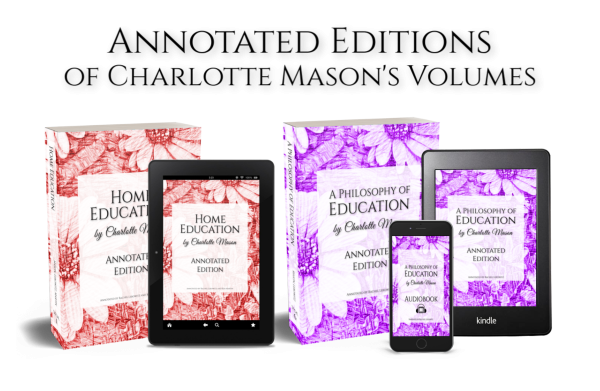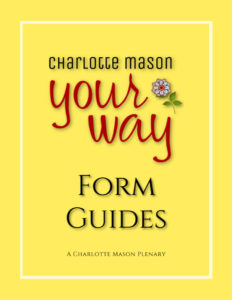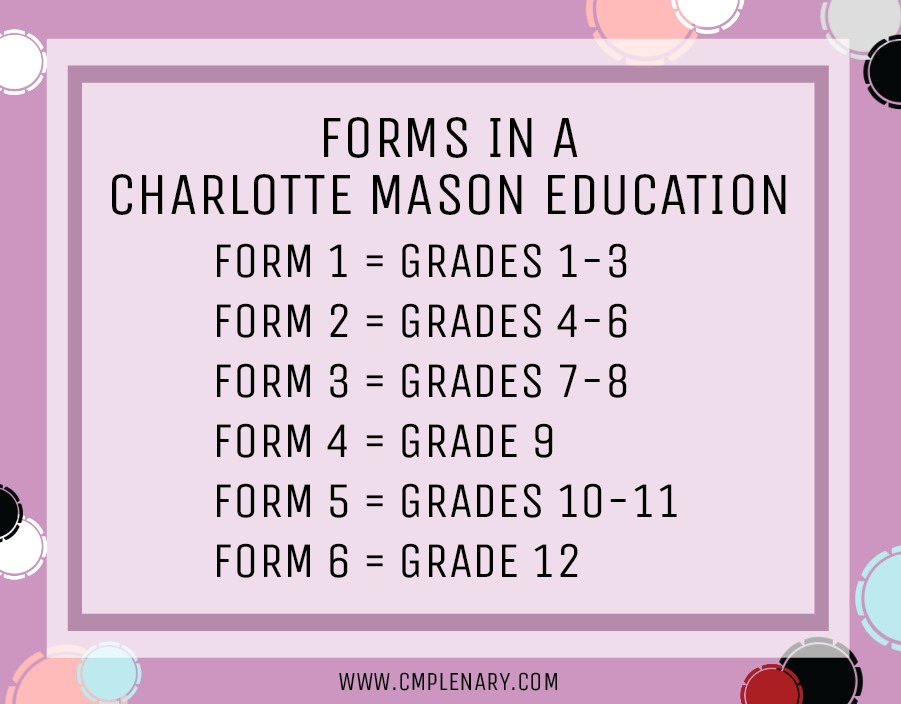UNDERSTANDING FORMS IN A CHARLOTTE MASON EDUCATION
Have you ever wondered what Forms are in a Charlotte Mason Education? Let’s make it easy and simple so that you can dive in to a Charlotte Mason education!
Here’s the gist of it – basically, the American school system uses Grades to indicate progression, such as Grade 1, Grade 2, etc., whereas the British school system uses Forms. And Charlotte Mason was, after all, a British Educator.
AN OVERVIEW OF FORMS
Here is a general overview of the Forms that Mason used, as compared to U.S. grade levels:

Those are the labels that you will find used most often to describe a Charlotte Mason education. But when we break it down even further, it gets more confusing. For example, most people break down Form 1 into
- Form 1B – Grade 1
- Form 1A – Grades 2 & 3
Or even further:
- Form 1B – Grade 1
- Form 1A Lower – Grade 2
- Form 1A Upper – Grade 3
FORM EXAMPLES FROM THE VOLUMES
These are all terms that Charlotte used in her writings, but they weren’t always consistent. The terms Class and Forms are also interchangeable.
Let’s look at some examples from her Home Education Series: Volumes 1-6. The clearest example comes from the appendix of Volume 3, where originally, Form 1A (not 1B) was the first year of formal schooling:
Class IA [Form 1A]: The child of six goes into Class 1A; he works for 2½ hours a day, but half an hour of this time is spent in drill and games. Including drill, he has thirteen ‘subjects’ of study, for which about sixteen books are used. (pg 272)
Class IB [Form 1B]: In Class IB, the children are usually between seven and eight, but may be nine. They have fifteen ‘subjects’ (perhaps twenty-three books). (pg 275)
Class II [Form 2]: In Class II, the children are between nine and twelve, occasionally over twelve. They have twenty-one ‘subjects,’ and about twenty-five books are used. They work from 9 to 12 each day, with half an hour’s interval for games and drill. (pg 280)
Class III [Form 3]: In Class III the range of age is from eleven or twelve to fifteen. Time, 3½ hours a day; half an hour out of this time, as before, for drill and games. There is no preparation or homework in any of the classes. (pg 286)
Class IV [Form 4]: [Students] are usually in Class IV for two or three years, from fourteen to seventeen, after which they are ready to specialize and usually do well. (pg 294)
Charlotte Mason, Home Education Vol. 3
Some PNEU Programmes show a Form 5 and a Form 6, but not all. When they are shown, the distinction between them is as follows:
- Form 4 – Grade 9
- Form 5 – Grades 10 & 11
- Form 6 – Grade 12
Appendix II in Volume 3 is titled “Some Specimens of Examination Work Done in the ‘Parents Review School’ in Which the Pupils are Educated Upon Books and Things.” It gives an overview of Exam questions and the answers given by the students.
But there’s more! Appendix C in Volume 1 also supports that Form 1A was the first year of formal schooling at age six.
Here you can see that the pupil was a child with the initials “B.B.” She was 7 years old and in Form 1B. Also, you can see that the Exam questions are easier in 1A than they are in 1B. This is consistent with the information above in Volume 3.
THE EXAMINATION OF A CHILD OF SEVEN IN CLASS 1B
[STUDENT] B.B., AGED 7 ½ YEARS
Exam Questions: Tales
1A: Tell a fairy tale
1B: Tell about the trial of Christian and Faithful in Vanity Fair [in Pilgrim’s Progress]
Tell about Odin’s journey to Jotunheim until he came to the land of giants (from Heroes of Asgard), or
Tell a short story from the History of Rome
Exam Questions: Arithmetic
1A: If Jack’s dinner costs 1s. 6d., how much will he have to pay for himself and three friends?
BEGINNERS: How many newts and how many robins have twenty-eight legs between them?
1B: Tom went to school at 6 ¼; he was 8 years and 3 months at one school, 4 years at another, 1 year and 9 months going round the world, 3 years and 3 months in Korea, and 5 ½ months in Japan. How old was he then?
BEGINNERS: Which is greater, and by how much, a quarter of a hundred or a fifth of a hundred?
Charlotte Mason, Home Education Vol. 1
PUBLICATION TIMELINE
Now, let’s look at the timeline of publication. Volumes 1 and 3 were originally published in 1885 and 1904. For reference, we are using the editions published in 1905 and 1907, respectively.
But Charlotte wrote Volume 6: A Philosophy of Education in 1921, some 36 years after Volume 1: Home Education.
Volume 6 was the culmination of her life’s work. We must, therefore, give more weight to the contents of this Volume.
When any conflicts arise among the Volumes, we defer to her final Volume as the last word on any given subject.
Such as, in Volume 6, we see 1A and 1B are now reversed:
- The child of six in 1B (pg 172)
- Children of seven are promoted to Form 1A in which they remain for a couple of years (pg 174)
- Form 1A (7 to 9) (pg 180)
So somewhere between the publications of Volume 3 and Volume 6, the distinction within Form 1 changed. We aren’t quite sure why, but it’s important to keep this tidbit of information in mind when reading her Volumes.
THE ANNOTATED CHARLOTTE MASON SERIES

In The Annotated Edition of Volume 1, we have included:
Appendix A: List of Books Used
Appendix C: The Examination of a Child in Form 1A
Appendix D: The Examination of a Child in Form 1B
None of those appendices have ever been reprinted anywhere else to our knowledge.
We believe the information in these appendices will be helpful in gaining an overview of not only the type of work assigned but also the children’s response to the work assigned.
We hope this information will be especially helpful as you read through Part 5: Lessons as Instruments of Education, which discusses the various subjects and how to teach them. We feel that the information in these Appendices is a wealth of information for parents striving to learn how to implement Charlotte’s method.
So, when reading this additional information, it is important to keep these distinctions in mind. But common sense tells us not to worry too much about it as long as we remember that the easier work was assigned to the younger child.
And here we see another reason for using Forms rather than Grades:
FORMS ARE FLEXIBLE
Forms allow for more flexibility in meeting the educational needs of a child. FORMS ARE ELASTIC; ADAPTABLE TO YOUR CHILD.
They allow you, the teacher, to increase or decrease the amount and difficulty of work based on your child’s ability and needs… whereas grades are more rigid and only allow for a certain scope and sequence to be learned within a certain year.
Let’s look at those age ranges again:
Charlotte Mason, Home Education Vol. 3
- Children in Form 1 are between the ages of 6 and 8, but may be age 9
- Children in Form 2 are between the ages of 9 and 12, occasionally over 12
- Children in Form 3 are between the ages of 11 or 12 to 15
- Children in Form 4 are between the ages of 14 to 17
The beauty of Forms is that FORMS ADJUST TO FIT YOUR CHILD. This is another example of how you can adapt the method YOUR WAY.
There is a lot of overlap in the entrance and exit of a Form.
A 9-year-old child can stay in Form 1 if needed.
A student of 11, 12, or even age 13 can be in either Form 2 or Form 3, depending on their current needs.
And a 14 or even 15-year-old student can choose to do the easier work assigned in Form 3 or move on to the more challenging work of Form 4.
But the key here is when they are ready.
Students advance WHEN THEY ARE READY. Each passage into a higher Form signals a shift in ability. Instead of moving students forward based on their ages, we move them based on their readiness and ability.
Do you have a 9-year-old that just isn’t ready for Shakespeare, Dictation, or Latin? Breathe easy because Form 1 is still a perfect – and reasonable – fit for your child!
CREATE YOUR OWN CHARLOTTE MASON CURRICULUM

Another way to use FORMS to honor and educate your students is to create your own CUSTOMIZED CHARLOTTE MASON CURRICULUM for your family.
Or TWEAK your current curriculum so that it is a better fit.
To help you do just that, I’ve created the CM YOUR WAY FORM GUIDES, which includes detailed information about what students studied in each Form.
Each Guide includes instructions on each subject, links to books that Charlotte used, and how to create a custom schedule for your family.
Forms are just another example of how, in a Charlotte Mason Education, we honor and educate the child as a WHOLE PERSON.


0 Comments for “Understanding Forms in a Charlotte Mason Education”